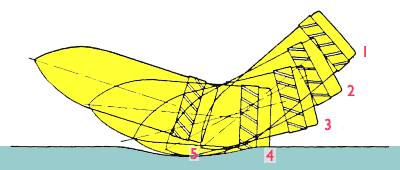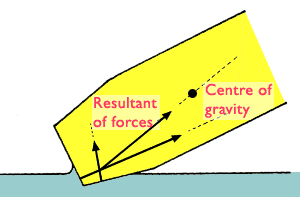
Logo from Scott Cunningham.

Logo from Scott Cunningham.
 ead shape has a pronounced effect on projectile performance. So far in this article an ogive of 1.4 c.r.h. has been assumed since this has been generally adopted for armour piercing projectiles. However, there is no head form which is best for all conditions of attack and it is of interest to consider the effect on penetration of changes in head shape.1
ead shape has a pronounced effect on projectile performance. So far in this article an ogive of 1.4 c.r.h. has been assumed since this has been generally adopted for armour piercing projectiles. However, there is no head form which is best for all conditions of attack and it is of interest to consider the effect on penetration of changes in head shape.1
The observed facts are that blunt heads perform better against thin plates, while longer heads give better performance against thick plates at normal, but not at angles.1
For normal attacks against thin plates, blunt heads need only about half the striking energy of pointed heads.
With plates around one calibre or less in thickness, penetration tends to occur by the formation of a plug of full plate thickness. Therefore the energy expended in driving a pointed head into the plate, before a calibre diameter plug can form, is largely wasted. Hence it would be expected that blunt headed projectiles would succeed at lower striking velocities. This is observed to be the case and flat fronted projectiles will succeed against thin plates with a striking energy only about half that necessary for ogival headed projectiles.1
As plate thickness is increased, however, the load necessary to produce a plug of full plate thickness becomes greater than the force necessary to cause penetration by radial displacement of plate material. As a result it is found that more pointed projectiles, which favour this mode of penetration, perform better than blunt projectiles. Moreover as plate thickness increases, the shock loading produced in blunt projectiles becomes so severe that the projectile breaks up. Thus, for normal attack of plates around 2 calibres thickness, head forms of 2 c.r.h. or even more pointed forms are found to be better than a 1.4 c.r.h. projectile.1
As angle of attack is increased, there is a progressive tendency to favour short head forms. This is so for two main reasons. Firstly the turning moments exerted on a projectile during angle attack are increased by increasing head length. Secondly, there must, in practice, be a reduction in plate thickness attacked, as angle is increased, if success is to be achieved.1

Stages in ricochet of a pointed projectile at a high angle of attack. Diagram from 1.
At angles of attack of 60° or so, ogival headed projectiles fail against quite thin plates, due to the fact that the initial turning moment on the projectile is sufficient to cause ricochet.1

A blunt head at high angles of attack reduces the tendency to ricochet. Moreover, if the head is shaped correctly then the resultant forces will pass through the body’s centre of gravity, resulting in all the kinetic energy being used for penetration instead of energy being wasted in turning action. Diagram from 1.
This tendency to ricochet can be reduced and the angle at which it occurs increased by the adoption of a suitable flat fronted head form. Moreover, such shaping of the head tends to make the projectile penetrate in such a manner that it uses all of its kinetic energy, rather than only that associated with the normal component, and so improves performance even at rather low angles where ricochet would not occur.1
British and USA armour piercing projectiles in World War II are usually around 1.4 c.r.h. since this was generally seen as the most satisfactory compromise for angles of attack around 30°,1 whereas German and Soviet armour piercing projectiles were much blunter. The British and USA projectiles would in theory would better against near vertical, thick (T/D>1) armour, but would be worse than German and Soviet projectiles against thick, sloped armour. This seems to be reflected by actual combat results.4
 Attack by Sub-Calibre Projectiles
Attack by Sub-Calibre Projectiles
Do you like this web site? Please rate it between one and ten, with ten being the best:
Ratings are submitted to: The Wargames and Military History Search Engine.
Copyright © 2000 David Michael Honner. E-mail: GvA@wargamer.org.